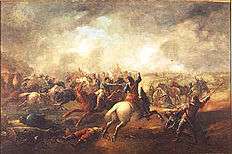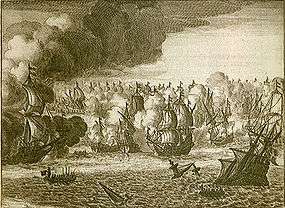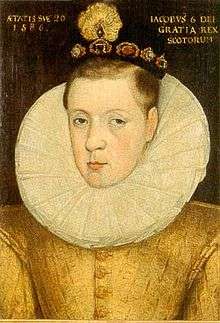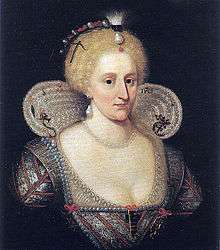Stuart period
| 1603–1714 | |
| Preceded by | Elizabethan era |
|---|---|
| Including | |
| Followed by | Georgian era |
| Monarch | |
| Periods in English history | ||||||||||||||||||||||||||||||||||||||||
|---|---|---|---|---|---|---|---|---|---|---|---|---|---|---|---|---|---|---|---|---|---|---|---|---|---|---|---|---|---|---|---|---|---|---|---|---|---|---|---|---|
|
||||||||||||||||||||||||||||||||||||||||
The Stuart period of British history usually refers to the period between 1603 and 1714 and sometimes from 1731 in Scotland. This coincides with the rule of the House of Stuart, whose first monarch of Scotland was Robert II but who during the reign of James VI of Scotland also inherited the throne of England. The period ended with the death of Queen Anne and the accession of George I from the House of Hanover. The Stuart period was plagued by internal and religious strife, and a large-scale civil war.
Significant events of the period
English civil war - War of the Three Kingdoms
The English Civil War(s) took place during the reign of Charles I, the second Stuart monarch. The war ended in victory for the Parliamentarians. Charles was executed in 1649.
After this conflict, the line of Stuart monarchs was temporarily displaced by the Commonwealth of England. Their rule lasted from 1649 to 1660. Oliver Cromwell ruled directly from 1653 to 1658. After Cromwell's death the Commonwealth fell apart. The Convention Parliament welcomed Charles II, son of Charles I, to return from war and become king. This event was known as the English Restoration.
Stuart foreign policy
Stuart England was consumed with internal affairs. During 1600-1650 the king made repeated efforts to colonize Guiana in South America. They all failed and the lands (Surinam) were ceded to the Dutch in 1667. James I's foreign policy placed much higher priority on European affairs.[1][2]
Anglo Dutch Wars
The Anglo-Dutch Wars were a series of three wars which took place between the English and the Dutch from 1652 to 1674. The causes included political disputes and increasing competition from merchant shipping. Religion was not a factor, since both sides were Protestant.[3] The British in the first war (1652–54) had the naval advantage with larger numbers of more powerful "ships of the line" which were well suited to the naval tactics of the era. The British also captured numerous Dutch merchant ships. In the second war (1665–67) Dutch naval victories followed. This second war cost London ten times more than it had planned on, and the king sued for peace in 1667 with the Treaty of Breda. It ended the fights over "mercantilism" (that is, the use of force to protect and expand national trade, industry, and shipping.) Meanwhile, the French were building up fleets that threatened both the Netherlands and Great Britain. In third war (1672–74), The British counted on a new alliance with France but the outnumbered Dutch outsailed both of them, and King Charles II ran short of money and political support. The Dutch gained domination of sea trading routes until 1713. The British gained the thriving colony of New Netherland, and renamed it New York.[4][5]
Glorious Revolution of 1688
Historians have long regarded the overthrow of King James II in 1688 as a decisive break in English history, especially as it made Parliament supreme over the King. Pincus argues that this revolution was the first modern revolution; it was violent, popular, and divisive. He rejects older theories to the effect that it was an aristocratic coup or a Dutch invasion. Instead, Pincus argues it was a widely supported and decisive rejection of James II. The people could not tolerate James any longer. He was too close to the French throne; he was too Roman Catholic; they distrusted his absolutist modernisation of the state. What they got instead was the vision of William of Orange, shared by most leading Englishmen, that emphasized consent of all the elites, religious toleration of all Protestant sects, free debate in Parliament and aggressive promotion of commerce. Pincus sees a dramatic transformation that reshaped religion, political economy, foreign policy and even the nature of the English state.[6][7]
Timeline
- 1603-1625
- Jacobean Era
- 1625-1642
- Caroline Era
- 1642-1651
- English Civil War
- 1651-1660
- English Interregnum
- 1660
- Restoration of Charles II
Monarchs
| Anne of Great Britain : Family Tree | ||||||||||||||||||||||||||||||||||||||||||||||||||||||||||||||||||||||||||||||||||||||||||||||||||||||||||||||||||||||||||||||||||||||||||||||||||||||||||||||||||||||||||||||||||||||||||||||||||||||||||||||||||||||||||||||||||||||||||||||||||||||||||||||||||||||||||||||||||||||||||||||||||||||||||||||||||||||||||||||||||||||||||||||||||||||||||||||||||||||||||||||||||||||||||||||||||||||||||||||||||||||||||||||||||||||||||||||||||||||||||||||||||||||||||||||||||||||||||||||||||||||||||||||||||||||||||||||||||||||||
|---|---|---|---|---|---|---|---|---|---|---|---|---|---|---|---|---|---|---|---|---|---|---|---|---|---|---|---|---|---|---|---|---|---|---|---|---|---|---|---|---|---|---|---|---|---|---|---|---|---|---|---|---|---|---|---|---|---|---|---|---|---|---|---|---|---|---|---|---|---|---|---|---|---|---|---|---|---|---|---|---|---|---|---|---|---|---|---|---|---|---|---|---|---|---|---|---|---|---|---|---|---|---|---|---|---|---|---|---|---|---|---|---|---|---|---|---|---|---|---|---|---|---|---|---|---|---|---|---|---|---|---|---|---|---|---|---|---|---|---|---|---|---|---|---|---|---|---|---|---|---|---|---|---|---|---|---|---|---|---|---|---|---|---|---|---|---|---|---|---|---|---|---|---|---|---|---|---|---|---|---|---|---|---|---|---|---|---|---|---|---|---|---|---|---|---|---|---|---|---|---|---|---|---|---|---|---|---|---|---|---|---|---|---|---|---|---|---|---|---|---|---|---|---|---|---|---|---|---|---|---|---|---|---|---|---|---|---|---|---|---|---|---|---|---|---|---|---|---|---|---|---|---|---|---|---|---|---|---|---|---|---|---|---|---|---|---|---|---|---|---|---|---|---|---|---|---|---|---|---|---|---|---|---|---|---|---|---|---|---|---|---|---|---|---|---|---|---|---|---|---|---|---|---|---|---|---|---|---|---|---|---|---|---|---|---|---|---|---|---|---|---|---|---|---|---|---|---|---|---|---|---|---|---|---|---|---|---|---|---|---|---|---|---|---|---|---|---|---|---|---|---|---|---|---|---|---|---|---|---|---|---|---|---|---|---|---|---|---|---|---|---|---|---|---|---|---|---|---|---|---|---|---|---|---|---|---|---|---|---|---|---|---|---|---|---|---|---|---|---|---|---|---|---|---|---|---|---|---|---|---|---|---|---|---|---|---|---|---|---|---|---|---|---|---|---|---|---|---|---|---|---|---|---|---|---|---|---|---|---|---|---|---|---|---|---|---|---|---|---|---|---|---|---|---|---|---|---|---|---|---|---|---|---|---|---|---|---|---|---|---|---|---|---|---|---|---|---|---|---|---|---|---|---|---|---|---|---|---|---|---|---|---|---|---|---|---|---|---|---|---|---|---|---|---|---|---|---|---|---|---|---|---|---|---|---|---|---|---|---|---|
| ||||||||||||||||||||||||||||||||||||||||||||||||||||||||||||||||||||||||||||||||||||||||||||||||||||||||||||||||||||||||||||||||||||||||||||||||||||||||||||||||||||||||||||||||||||||||||||||||||||||||||||||||||||||||||||||||||||||||||||||||||||||||||||||||||||||||||||||||||||||||||||||||||||||||||||||||||||||||||||||||||||||||||||||||||||||||||||||||||||||||||||||||||||||||||||||||||||||||||||||||||||||||||||||||||||||||||||||||||||||||||||||||||||||||||||||||||||||||||||||||||||||||||||||||||||||||||||||||||||||||
| Periods in English history | ||||||||||||||||||||||||||||||||||||||||
|---|---|---|---|---|---|---|---|---|---|---|---|---|---|---|---|---|---|---|---|---|---|---|---|---|---|---|---|---|---|---|---|---|---|---|---|---|---|---|---|---|
|
||||||||||||||||||||||||||||||||||||||||
The House of Stuart produced six English monarchs who ruled during this period.
The early Stuarts.
- King James I (1603 to 1625).
- King Charles I (1625 to 1649).
The late Stuarts.
- King Charles II (1660 to 1685).
- King James II (1685 to 1688).
- Queen Mary II (1689 to 1702). Reigned with William III of House of Orange-Nassau.
- Queen Anne (1702 to 1714)
Historical gallery



References
- ↑ Joyce Lorimer, "The failure of the English Guiana ventures 1595–1667 and James I's foreign policy." Journal of Imperial and Commonwealth History 21#.1 (1993): 1-30.
- ↑ Albert J. Loomie, Spain & the Early Stuarts, 1585-1655 (1996)
- ↑ Steven C. A. Pincus, Protestantism and Patriotism: Ideologies and the Making of English Foreign Policy, 1650-1668 (1996)
- ↑ James Rees Jones, The Anglo-Dutch wars of the seventeenth century (1996) online
- ↑ Gijs Rommelse, "The role of mercantilism in Anglo‐Dutch political relations, 1650–74." Economic History Review 63#3 (2010): 591-611.
- ↑ Steve Pincus, 1688: The First Modern Revolution (2011)
- ↑ Steven C. A. Pincus, England's Glorious Revolution 1688-1689: A Brief History with Documents (2005)
Further reading
- Campbell, Mildred. English yeoman under Elizabeth and the early Stuarts (1942), rich coverage of rural life
- Clark, George Norman. The Later Stuarts, 1660–1714 (Oxford History of England) (1956), standard scholarly survey
- Coward, Barry. The Stuart Age: England, 1603-1714 (1980)
- Coward, Barry, ed. A Companion to Stuart Britain (2009) excerpt and text search; 24 advanced essays by scholars
- Davies, Godfrey. The Early Stuarts, 1603–1660 (Oxford History of England) (1959)
- Kishlansky, Mark A. A Monarchy Transformed: Britain, 1603–1714 (Penguin History of Britain) (1997), standard scholarly survey; excerpt and text search
- Lipson, Ephraim. The economic history of England: vol 2: The Age of Nercantilism (7th ed. 1964)
- Miller, John. The Stuarts (2004)
- Morrill, John. Stuart Britain: A Very Short Introduction (2005) excerpt and text search; 100pp
- Morrill, John, ed. The Oxford Illustrated History of Tudor and Stuart Britain (2001) excerpt and text search
- Notestein, Wallace. English people on the eve of colonization, 1603-1630 (1954). scholarly study of occupations and roles
- Pincus, Steve. 1688: The First Modern Revolution (2011)
- Pincus, Steven C. A. England's Glorious Revolution 1688-1689: A Brief History with Documents (2005)
- Sharpe, Kevin, and Peter Lake, eds. Culture and politics in early Stuart England (1993)
- Wroughton, John. ed. The Routledge Companion to the Stuart Age, 1603-1714 (2006) excerpt and text search
Historiography
- Baxter, Steven B. "The Later Stuart's: 1660-1714," in Richard Schlatter, ed., Recent Views on British History: Essays on Historical Writing since 1966 (Rutgers UP, 1984), pp 141 – 166
- Burgess, Glenn. "On revisionism: an analysis of early Stuart historiography in the 1970s and 1980s." Historical Journal (1990) 33#3 pp: 609-627.
- Furber, Elizabeth Chapin, ed. Changing Views on British History (1966)
- Underdown, David. "New Ways and Old and Early Stuart History," in Richard Schlatter, ed., Recent Views on British History: Essays on Historical Writing since 1966 (Rutgers UP, 1984), pp 99–140
- Zagora, Perez. "English History, 1558-1640: A Bibliographical Survey," in Elizabeth Chapin Furber, ed. Changing views on British history: essays on historical writing since 1939 (Harvard University Press, 1966), pp 119–40
Primary sources
- Browning, A. ed. English Historical Documents 1660-1714 (1953)
- Coward, Barry, and Peter Gaunt, eds. English Historical Documents, 1603-1660 (2011)
| House of Stuart | ||
| Preceded by House of Bruce |
Ruling house of the Kingdom of Scotland 1371–1649 |
Vacant |
| Preceded by House of Tudor |
Ruling house of the Kingdom of England 1603–1649 |
Vacant |
| Vacant | Ruling house of the Kingdom of Scotland 1660–1707 |
Titles merged by the Acts of Union 1707 |
| Vacant | Ruling house of the Kingdom of England 1660–1707 | |
| New title England and Scotland united |
Ruling house of the Kingdom of Great Britain 1606–1714 |
Succeeded by House of Hanover |







.jpg)
.jpg)





